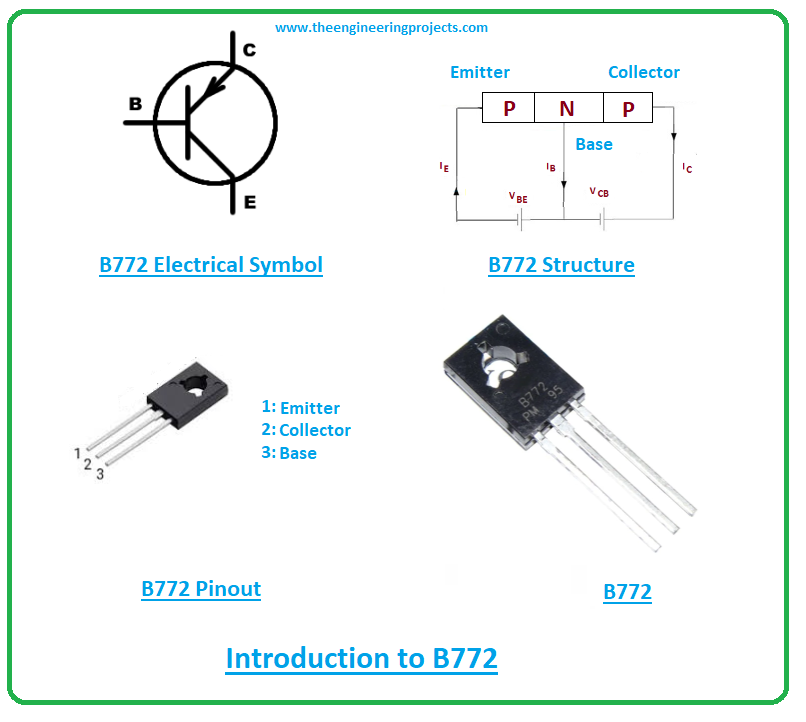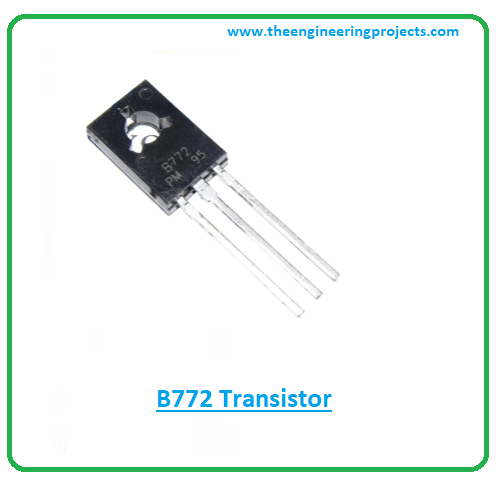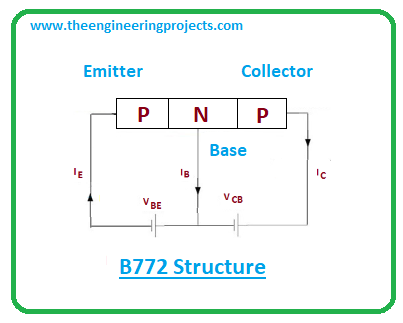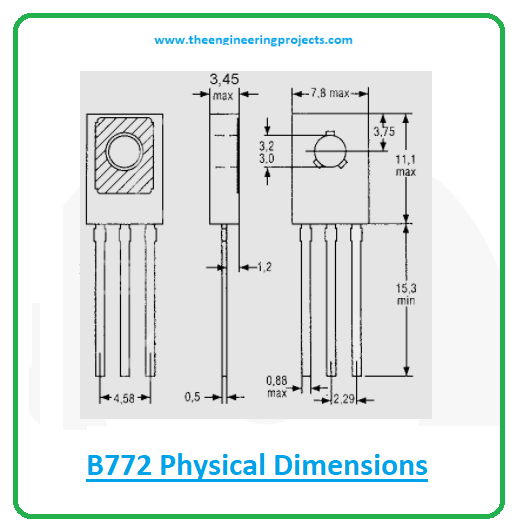
Introduction to B772
- B772 is a bipolar junction transistor that falls under the category of PNP transistors.
- It contains three pins called the emitter, collector, and base terminals. During the amplification process in the circuit, the small input current present at the base terminal is used to produce large output current at the remaining terminals.
- This PNP transistor is made up of silicon material and comes in the TO-126 package.
- B772 comes with three layers where two are p-doped layers and one is n-doped. The n-doped layer stands between two p-doped layers.

- The two n-doped layers represent collector and emitter and one n-doped layer represents the base terminal and indicates the base terminal requires a negative voltage supply to start the transistor action.
- You know it already, both electrons and holes play a crucial role in the conductivity process inside the transistor, in the case of PNP transistor holes are majority carriers and electrons are minority carriers in the case of NPN transistors.
- In comparison, NPN transistors are preferred over PNP transistors because the mobility of electrons is better than the movement of holes in the PNP transistor. In rare cases, both PNP and its complementary NPN transistors are incorporated inside a single circuit.
- This device is produced using planer technology that generates rugged high-performance components.
B772 Datasheet
The datasheet of any component exhibits the main characteristics of the device. It will help you get a hold of the current and voltage required for the emitter, collector, and base terminals. Click below to download the datasheet of B772.B772 Pinout
B772 carries three main terminals that are known as: 1: Emitter 2: Collector 3: Base The following figure shows the pinout diagram of B772.
- These terminals are used for the external connection with the electronic circuit. All these pins exhibit different doping concentrations and different functionality.
- The emitter side is more doped compared to other terminals. Moreover, the emitter terminal contains the entire current of the transistor i.e. Ie = Ic + Ib
B772 Working Principle
- B772 is a low saturation voltage and high current device where the base terminal is responsible for the overall transistor action.
- The emitter and collector side is reverse biased when there is current present at the base terminal and in that case, the device is considered turned OFF.

- And when there is no current at the base side, both collector and emitter are forward biased and the transistor is turned ON.
- Recall, this is a PNP transistor, here the n-doped layer represents the base side that is negative. The negative voltage supply is applied at the base side to start the transistor working process.
B772 Power Ratings
The following table shows the absolute maximum ratings of the device B772.| Absolute Maximum Ratings B772 | ||||
|---|---|---|---|---|
| No. | Rating | Symbol | Value | Unit |
| 1 | Collector-Emitter Voltage | Vce | 30 | V |
| 2 | Collector-Base Voltage | Vcb | 60 | V |
| 3 | Emitter-Base Voltage | Veb | 5 | V |
| 4 | Collector Current | Ic | 3 | A |
| 5 | Current Gain | hfe | 30 to 300 | |
| 6 | Power Dissipation | Ptot | 12.5 | W |
| 7 | Storage Temperature | Tstg | -65 to 150 | C |
- You can see from the table, the 60V is the collector-base voltage and 30V is the voltage between collector and emitter. While the voltage between emitter and base is 5V.
- Total power dissipation is 12.5W which signals the amount of energy released during the working of this transistor.
- Junction temperature is 150C and storage temperature stands between 65 to 150C
- These are called stress ratings. When you incorporate this device into your project, make sure ratings don’t surpass the absolute maximum ratings.
- If they exceed the required ratings, it will damage the device and thus the entire project.
Difference between PNP and NPN transistors
- Both NPN and PNP are bipolar junction transistors and work similarly with a few exceptions. The current directions and voltage polarities are reversed.
- In the case of PNP transistor, the conductivity is carried out from the emitter to the collector side while in the case of NPN transistor the conductivity process is carried out from the collector to the emitter side.

- Moreover, the holes are majority carriers in the case of PNP transistors and minority carriers in the case of NPN transistors. While electrons are majority carriers in NPN transistors and minority carriers in the case of PNP transistors.
- And negative voltage is applied at the base pin in the PNP transistor and a positive voltage is applied at the base terminal in the case of NPN transistor.
B772 Alternatives
The following are the alternative to B772.- BD186
- BD132
- KSB772
- BD188
- BD190
- MJE232
- KSH772
- MJE235
B772 Applications
- Used for medium-power switching and amplification applications.
- Used in the motor control circuit.
- Incorporated in relay drivers.
- Incorporated in voltage regulator circuits.
- Used to drive loads under 3A.
- Employed in Astable and Bistable multivibrators.
- Employed in H-bridge circuits.
B772 Physical dimensions
The following figure exhibits the physical dimensions of the component that help you identify and evaluate the total space required for the circuit.



